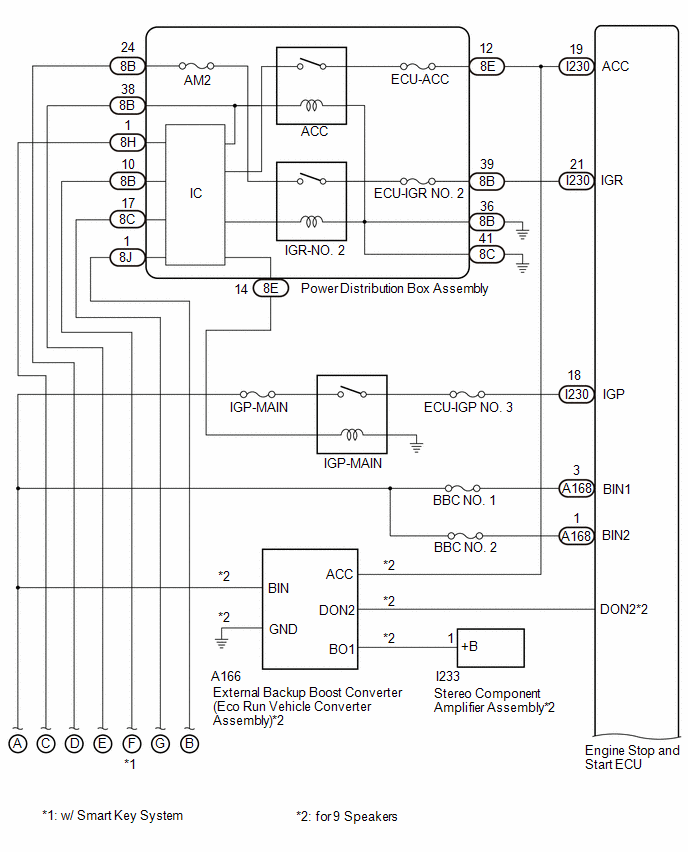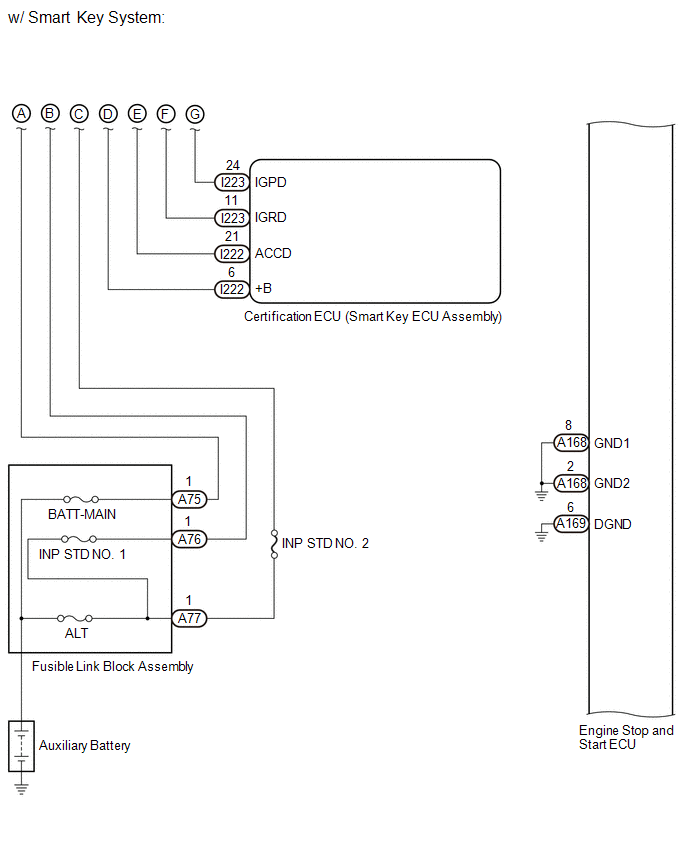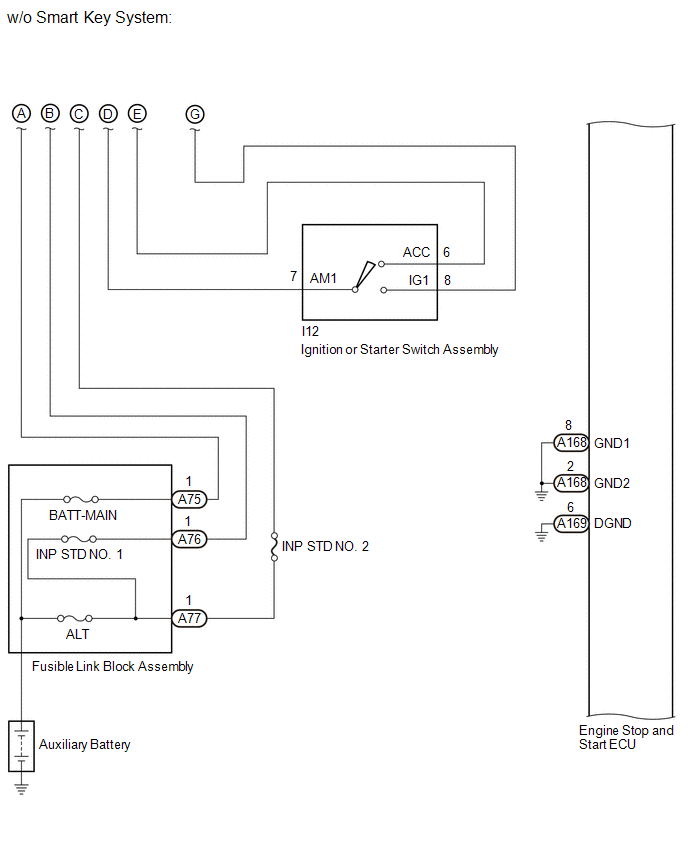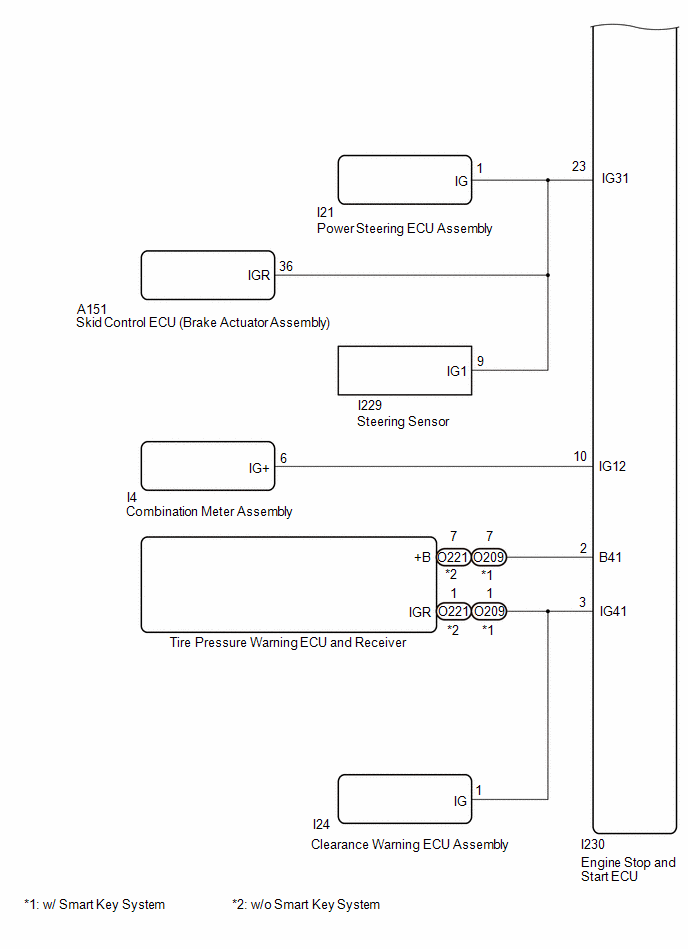Toyota Corolla Cross: Backup Boost Converter "A" (P323A00,P323A16,P323B14,P323B29,P323B38)
DESCRIPTION
A backup boost converter is built into the engine stop and start ECU.
The backup boost converter helps maintain auxiliary battery voltage to prevent various functions from failing if power source voltage supplied from the backup boost converter drops due to the high electrical load when the engine is restarted by stop and start control.
The backup boost converter helps maintain the power source voltage if the auxiliary battery voltage drops due to the high electrical load when the engine is restarted by stop and start control.
HINT:
A relay function and fuse function are provided in the backup boost converter.
If there is a malfunction in any of the electrical system circuits connected to the backup boost converter, the fuse and relay functions shut off the malfunctioning circuit to protect other circuits (remains shut off until next trip).
When the electrical system circuit is shut off, power to the circuit is cut off, causing any systems connected to the circuit to be disabled.
The fuse function is reset* when the ignition switch is turned off. If the malfunction still exists in the electrical system circuit that has been shut off by the relay function, it will be shut off again by the relay and fuse functions the next time the ignition switch is turned to ON.
*: A semiconductor fuse self resets according to electric signal.
The backup boost converter supplies power to:- Meter / gauge system
- Power steering system
- Audio and visual system
- Tire pressure warning system
- Toyota Safety Sense
- Parking support brake system
|
DTC No. | Detection Item |
DTC Detection Condition | Trouble Area |
MIL | Warning Indicate |
Note |
|---|---|---|---|---|---|---|
| P323A00 |
Backup Boost Converter "A" |
The following conditions is met for 1 second or more (1 trip detection logic):
|
| Comes on (For Mexico Models: Does not come on) |
Does not come on (For Mexico Models: Blinks) |
SAE Code: P323A |
|
P323A16 | Backup Boost Converter "A" Circuit Voltage Below Threshold |
One of the following conditions is met for 2 second or more (1 trip detection logic):
|
| Does not come on |
Does not come on (For Mexico Models: Blinks) |
SAE Code: P323A |
|
P323B14 | Backup Boost Converter "A" Control Circuit Circuit Short to Ground or Open |
The following conditions is met for 1 second or more (1 trip detection logic):
|
| Comes on (For Mexico Models: Does not come on) |
Does not come on (For Mexico Models: Blinks) |
SAE Code: P323D |
|
P323B29 | Backup Boost Converter "A" Control Circuit Signal Invalid |
The following conditions is met for 1 second or more (1 trip detection logic):
|
| Comes on (For Mexico Models: Does not come on) |
Does not come on (For Mexico Models: Blinks) |
SAE Code: P323C |
|
P323B38 | Backup Boost Converter "A" Control Circuit Signal Cycle Invalid |
The following conditions is met for 1 second or more (1 trip detection logic):
|
| Comes on (For Mexico Models: Does not come on) |
Does not come on (For Mexico Models: Blinks) |
SAE Code: P323C |
MONITOR STRATEGY
|
Related DTCs | P323A, P323D, P323C: Starter / generator control module internal back up boost converter performance |
|
Required Sensors/Components (Main) | Engine stop and start ECU |
|
Required Sensors/Components (Related) | - |
|
Frequency of Operation | Continuous |
|
Duration | 1 second |
| MIL Operation |
Immediate |
| Sequence of Operation |
None |
TYPICAL ENABLING CONDITIONS
P323A, P323C (Case1), P323D|
All of the following conditions are met |
- |
| Battery voltage |
8 V or higher |
|
Write Inhibit | permit |
|
Time after Write status forbiddance to permit |
0.5 seconds or more |
|
Ignition switch | ON |
|
Time after ignition switch is off to ON |
0.5 seconds or more |
|
Starter | OFF |
|
Time after starter on to off |
0.5 seconds or more |
|
Engine stop and start ECU internal back up boost converter fail (P323C) |
Not detected |
|
Monitor runs whenever the following DTCs are not stored |
None |
| All of the following conditions are met |
- |
| Time after engine stop and start ECU power ON |
0.1 seconds or more |
|
Back up boost converter control IC status signal frequency |
Less than 50 Hz |
TYPICAL MALFUNCTION THRESHOLDS
P323A (Case 1)|
The following condition is met | 2 times or more |
|
Back up boost converter control IC power supply voltage |
Higher than 5.8 V |
|
Both of the following conditions are met |
20 times or more |
| Back up boost converter boosted voltage |
17 V or higher |
| Time after Engine restart by engine stop and start ECU |
Less than 1 second |
|
Both of the following conditions are met |
13 times or more |
| Back up boost converter boosted voltage |
9 V or less |
| Time after Engine restart by engine stop and start ECU |
Less than 1 second |
|
Both of the following conditions are met |
13 times or more |
| Back up boost converter feedback control voltage |
2.7 V or higher |
| Time after Engine restart by engine stop and start ECU |
Less than 1 second |
|
Both of the following conditions are met |
2 times or more |
| Back up boost converter boosted voltage |
3 V or less |
| Battery voltage detected by back up boost converter control IC |
4.6 V or higher |
|
Both of the following conditions are met |
98 times or more |
| Back up boost converter circuit negative power supply voltage |
Higher than -1.8 V |
| Back up boost converter control IC power supply voltage |
4.2 V or higher |
|
The following condition is met | 2 times or more |
|
Difference between positive voltage and negative voltages (Back up boost converter output current sensor circuit) |
Higher than 0.085 V |
|
The following condition is met | 8 times or more |
|
Back up boost converter output current sensor circuit resistance |
More than 450000 Ω |
|
One of the following conditions (a), (b), (c), (d), (e), (f), (g) or (h) is met |
- |
| (a) Number of back up boost converter control IC status signal pulse |
Less than 3 times |
|
(b) Back up boost converter control IC status signal frequency |
Less than 90.91 Hz |
|
(c) Back up boost converter control IC status signal frequency |
Higher than 111.11 Hz |
|
(d) Back up boost converter control IC status signal duty cycle |
Higher than 0%, and less than 7.5% |
|
(e) Back up boost converter control IC status signal duty cycle |
Higher than 17.5%, and less than 32.5% |
|
(f) Back up boost converter control IC status signal duty cycle |
Higher than 42.5%, and less than 57.5% |
|
(g) Back up boost converter control IC status signal duty cycle |
Higher than 67.5%, and less than 82.5% |
|
(h) Back up boost converter control IC status signal duty cycle |
Higher than 92.5%, and less than 100% |
|
Back up boost converter control IC power supply voltage |
Less than 3 V |
CONFIRMATION DRIVING PATTERN
HINT:
- If the cable is disconnected from the auxiliary battery terminal, stop and start control is prohibited until refresh charge is completed.
In this case, let the vehicle idle to complete the refresh charge. The refresh charge is complete when the Data List item Status of Battery Charge Control changes from "Refresh Charge Mode". (Usually, by idling the engine for 5 to 60 minutes with the auxiliary battery fluid temperature at 11°C (52°F) or higher, the refresh charge will be completed.)
- If the GTS is not available and the Data List item Status of Battery Charge Control cannot be checked, charge the auxiliary battery by idling the engine for approximately 5 to 60 minutes or driving the vehicle, and then drive the vehicle and check that stop and start control operates.
If the engine is started with the hood open, the system determines that a jump start has occurred. Therefore, make sure that the hood is closed before starting the engine and driving the vehicle.
- After the refresh charge completes, turn the ignition switch off, wait for at least 30 seconds, and then start the engine again. If the vehicle enters refresh charge mode again while the engine is idling, the initial refresh charge did not properly complete, so wait for the refresh charge to complete.
- Allow the engine to idle for 3 minutes after it is warmed up and check that the engine idle speed is within 50 rpm of the target idle speed.
- When clearing the permanent DTCs, refer to the "CLEAR PERMANENT DTC" procedure (except Mexico Models).
Click here
.gif)
- When clearing the permanent DTCs, do not disconnect the cable from the battery terminal or attempt to clear the DTCs during this procedure, as doing so will clear the universal trip and normal judgment histories (except Mexico Models).
CONFIRMATION AFTER TROUBLESHOOTING
(a) Clear the DTCs.
Powertrain > Stop and Start > Clear DTCs(b) Start the engine and warm it up.
(c) Drive the vehicle at 7 km/h (4 mph) or more.
CAUTION:
When performing Confirmation Driving Pattern, obey all speed limits and traffic laws.
(d) Depress the brake pedal and stop the vehicle.
(e) Keep the engine stopped by stop and start control for 1 second or more. (Keep the shift lever in D.)
(f) Release the brake pedal with the shift lever in D to start the engine.
HINT:
If the engine cranks slowly when the engine is restarted, it can be determined that the auxiliary battery voltage is low.
(g) Check that DTCs are not output.
Powertrain > Stop and Start > Trouble CodesSTOP AND START SYSTEM OPERATION CHECK
Click here
.gif)
WIRING DIAGRAM




CAUTION / NOTICE / HINT
NOTICE:
- Before replacing the engine stop and start ECU, read the number of starter operations and write it into a new engine stop and start ECU.
Click here
.gif)
- After replacing the engine stop and start ECU, perform learning of the external backup boost converter (eco run vehicle converter assembly).
Click here
.gif)
- After replacing the engine stop and start ECU or air conditioning amplifier assembly, reset and perform learning of the air conditioning information in the engine stop and start ECU.
Click here
.gif)
- When the engine stop and start ECU or oil pump with motor assembly is replaced, check the oil pump with motor assembly.
Click here
.gif)
- Inspect the fuses for circuits related to this system before performing the following procedure.
HINT:
- Using the GTS, read the freeze frame data before troubleshooting. System condition information is recorded as freeze frame data the moment a DTC is stored. This information can be useful when troubleshooting.
Click here
.gif)
- For wire harness and connector inspection procedures and precautions, refer to "
.gif) "
"
- DTCs for the stop and start system are not cleared even if the malfunction has been repaired. After repairing the malfunction, be sure to clear the DTCs.
PROCEDURE
|
1. | CHECK HARNESS AND CONNECTOR (ENGINE STOP AND START ECU - BBC NO.1 FUSE AND BBC NO. 2 FUSE) |
(a) Disconnect the A168 engine stop and start ECU connector.
(b) Remove the BBC NO. 1 fuse and BBC NO. 2 fuse from the No. 1 engine room relay block.
(c) Measure the resistance according to the value(s) in the table below.
Standard Resistance:
|
Tester Connection | Condition |
Specified Condition |
|---|---|---|
|
A168-1 (BIN2) - 2 (BBC NO. 2 fuse holder) |
Always | Below 1 Ω |
|
A168-3 (BIN1) - 2 (BBC NO. 1 fuse holder) |
Always | Below 1 Ω |
|
A168-1 (BIN2) - Body ground and other terminals |
Always | 10 kΩ or higher |
|
2 (BBC NO. 2 fuse holder) - Body ground and other terminals |
Always | 10 kΩ or higher |
|
A168-3 (BIN1) - Body ground and other terminals |
Always | 10 kΩ or higher |
|
2 (BBC NO. 1 fuse holder) - Body ground and other terminals |
Always | 10 kΩ or higher |
| NG | .gif) | REPAIR OR REPLACE HARNESS OR CONNECTOR |
|
| 2. |
CHECK HARNESS AND CONNECTOR (ENGINE STOP AND START ECU POWER SOURCE CIRCUIT) |
(a) Disconnect the A168 and I230 engine stop and start ECU connectors.
(b) Measure the voltage according to the value(s) in the table below.
Standard Voltage:
|
Tester Connection | Condition |
Specified Condition |
|---|---|---|
|
A168-1 (BIN2) - Body ground |
Always | 9.5 to 14 V |
|
A168-3 (BIN1) - Body ground |
Always | 9.5 to 14 V |
(c) Turn the ignition switch to ON.
(d) Measure the voltage according to the value(s) in the table below.
Standard Voltage:
|
Tester Connection | Condition |
Specified Condition |
|---|---|---|
|
I230-18 (IGP) - Body ground |
Always | 9.5 to 14 V |
| NG | .gif) | REPAIR OR REPLACE HARNESS OR CONNECTOR |
|
| 3. |
CHECK HARNESS AND CONNECTOR (ENGINE STOP AND START ECU - BODY GROUND) |
(a) Disconnect the A168 and A169 engine stop and start ECU connectors.
(b) Measure the voltage according to the value(s) in the table below.
Standard Voltage:
|
Tester Connection | Condition |
Specified Condition |
|---|---|---|
|
A168-8 (GND1) - Body ground |
Always | 9.5 to 14 V |
|
A168-2 (GND2) - Body ground |
Always | 9.5 to 14 V |
|
A169-6 (DGND) - Body ground |
Always | 9.5 to 14 V |
| NG | .gif) | REPAIR OR REPLACE HARNESS OR CONNECTOR |
|
| 4. |
CHECK HARNESS AND CONNECTOR (ENGINE STOP AND START ECU - EACH ECU OR SENSOR) |
(a) Disconnect the I230 engine stop and start ECU connector.
(b) Disconnect the I4 combination meter assembly connector.
(c) Disconnect the I21 power steering ECU assembly connector.
(d) Measure the resistance according to the value(s) in the table below.
Standard Resistance:
|
Tester Connection | Condition |
Specified Condition |
|---|---|---|
|
I230-10 (IG12) - I4-6 (IG+) |
Always | Below 1 Ω |
|
I230-23 (IG31) - I21-1 (IG) |
Always | Below 1 Ω |
|
I230-10 (IG12) - Body ground and other terminals |
Always | 10 kΩ or higher |
|
I230-23 (IG31) - Body ground and other terminals |
Always | 10 kΩ or higher |
| NG | .gif) | REPAIR OR REPLACE HARNESS OR CONNECTOR |
|
| 5. |
CHECK VEHICLE SPECIFICATION |
(a) Check the vehicle specification
| Result |
Proceed to |
|---|---|
| w/ Smart Key System |
A |
| w/o Smart Key System |
B |
| B |
.gif) | GO TO STEP 8 |
|
| 6. |
CHECK HARNESS AND CONNECTOR (ENGINE STOP AND START ECU - EACH ECU OR SENSOR) |
(a) Disconnect the I230 engine stop and start ECU connector.
(b) Disconnect the O209 tire pressure warning ECU and receiver connector.
(c) Measure the resistance according to the value(s) in the table below.
Standard Resistance:
|
Tester Connection | Condition |
Specified Condition |
|---|---|---|
|
I230-2 (B41) - O209-7 (+B) |
Always | Below 1 Ω |
|
I230-2 (B41) - Body ground and other terminals |
Always | 10 kΩ or higher |
| NG | .gif) | REPAIR OR REPLACE HARNESS OR CONNECTOR |
|
| 7. |
CHECK HARNESS AND CONNECTOR (ENGINE STOP AND START ECU - EACH ECU OR SENSOR) |
(a) Disconnect the I230 engine stop and start ECU connector.
(b) Disconnect the I24 clearance warning ECU assembly connector.
(c) Measure the resistance according to the value(s) in the table below.
Standard Resistance:
|
Tester Connection | Condition |
Specified Condition |
|---|---|---|
|
I230-3 (IG41) - I24-1 (IG) |
Always | Below 1 Ω |
|
I230-3 (IG41) - Body ground and other terminals |
Always | 10 kΩ or higher |
| OK | .gif) | REPLACE ENGINE STOP AND START ECU |
| NG | .gif) | REPAIR OR REPLACE HARNESS OR CONNECTOR |
| 8. |
CHECK HARNESS AND CONNECTOR (ENGINE STOP AND START ECU - EACH ECU OR SENSOR) |
(a) Disconnect the I230 engine stop and start ECU connector.
(b) Disconnect the O221 tire pressure warning ECU and receiver connector.
(c) Measure the resistance according to the value(s) in the table below.
Standard Resistance:
|
Tester Connection | Condition |
Specified Condition |
|---|---|---|
|
I230-2 (B41) - O221-7 (+B) |
Always | Below 1 Ω |
|
I230-2 (B41) - Body ground and other terminals |
Always | 10 kΩ or higher |
| OK | .gif) | GO TO STEP 7 |
| NG | .gif) | REPAIR OR REPLACE HARNESS OR CONNECTOR |

.gif)

